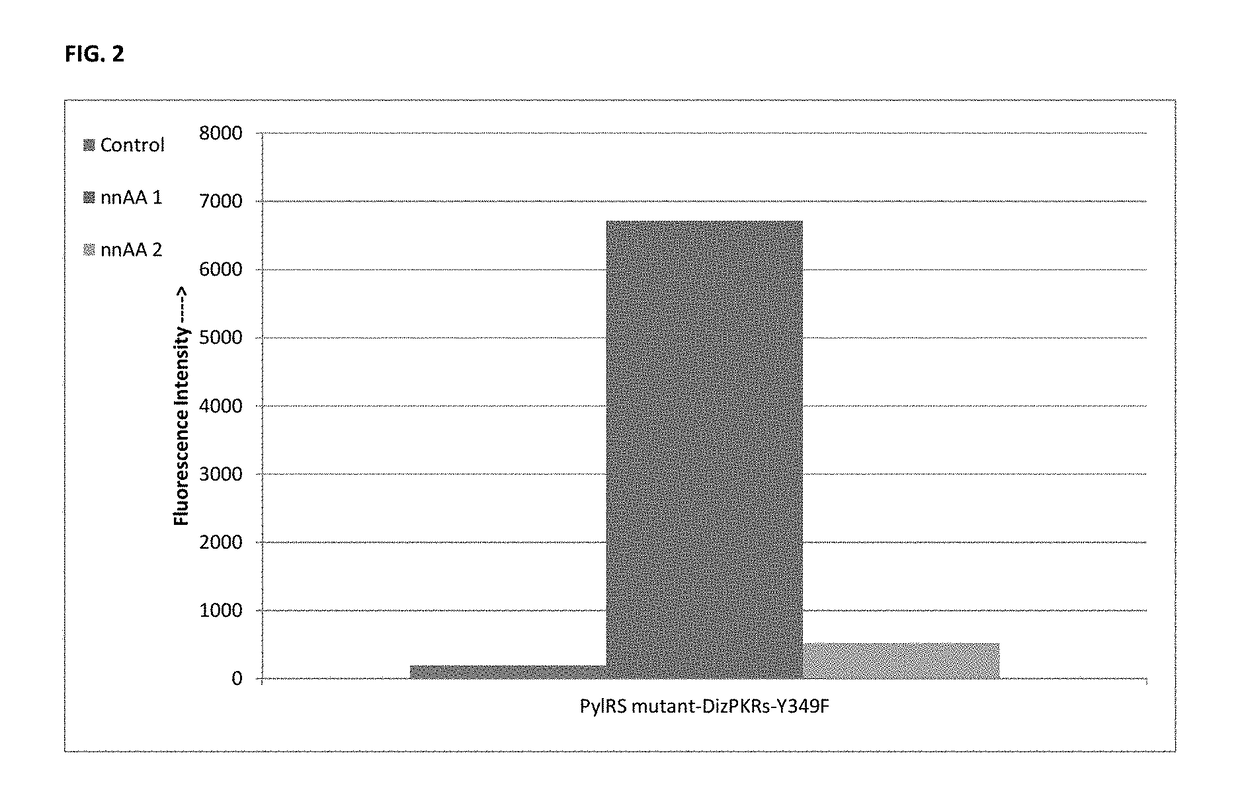Functionally modified polypeptides and radiobiosynthesis
a functionally modified polypeptide and radiobiosynthesis technology, applied in the field of protein drugs, can solve the problems of shrinking the therapeutic window, negative impact on patient compliance, and increasing the risk of side effects, and achieves greater in vivo stability, stable peptidase activity, and stable in vivo hydrolysis.
- Summary
- Abstract
- Description
- Claims
- Application Information
AI Technical Summary
Benefits of technology
Problems solved by technology
Method used
Image
Examples
example 1
d Synthesis and Radiosynthesis
[0143]The two non-natural amino acids (nnAAs 1 and 2; FIG. 1) were synthesized from the corresponding NHS-esters by standard conjugation chemistry (FIG. 1). We performed a chromatographic assay of HSA binding (Hage D S, Austin J. High-performance affinity chromatography and immobilized serum albumin as probes for drug- and hormone-protein binding. J Chromatogr B Biomed Sci Appl. 2000; 739, 39-54) for these two tags (Kd=7.0 μM for 1; Kd=204 μM for 2) and confirmed the significant difference in HSA affinity observed previously (Dumelin C E, et al. A portable albumin binder from a DNA-encoded chemical library. Angew Chem, Int Ed. 2008; 47, 3196-201). To establish that radiolabeled 1 and 2 could be prepared on a timescale commensurate with protein biosynthesis, diaryliodonium salt precursors 5 and 6 (FIG. 1) were treated with no-carrier-added (n.c.a.) Na124I (2 mCi) to afford 124I-labeled 3 and 4 in excellent radiochemical yield with little to no hydrolysis...
example 2
ynthesis Using 1 and 2
[0145]Pyrrolysyl-tRNA synthetase (PyIRS) and its cognate tRNACUAPyt naturally incorporate pyrrolysine (Pyl) in response to the amber nonsense codon in some methanogenic archaea (Blight S K, et al. Direct charging of tRNACUA with pyrrolysine in vitro and in vivo. Nature. 2004; 431, 333-5; Srinivasan G, et al. Pyrrolysine Encoded by UAG in Archaea: Charging of a UAG-Decoding Specialized tRNA. Science. 2002; 296, 1459-62). Previous work has shown that tRNACUAPyt is not recognized by endogenous aminoacyl-t-RNA synthetases (AARSs) in E. coli or mammalian cells (Polycarpo C, et al. An aminoacyl-tRNA synthetase that specifically activates pyrrolysine. Proc Natl Acad Sci USA. 2004; 101, 12450-4; Nozawa K, et al. Pyrrolysyl-tRNA synthetase-tRNAPyl structure reveals the molecular basis of orthogonality. Nature. 2009; 457, 1163-7; Chen P R, et al. A Facile System for Encoding Unnatural Amino Acids in Mammalian Cells. Angew Chem Int Ed. 2009; 48, 4052-5), and that non-natu...
example 3a
on of the Hit from the Initial Screen
[0148]The most promising hit from the initial screen (DizPKRs-Y349F, FIG. 2) serves as the basis for an additional mutant library, generated using error-prone PCR. A previously established selection system (Chen P R, et al. A Facile System for Encoding Unnatural Amino Acids in Mammalian Cells. Angew Chem Int Ed. 2009; 48, 4052-5) is used to identify PyIRS mutants with increased activities. Briefly, the library is subjected to consecutive rounds of negative selection and positive selection using reporter genes containing an amber codon at a permissive position. The positive selection identifies functional PyIRS mutants and is based on cells' resistance to chloramphenicol, which is conferred by the suppression of an amber mutation in the chloramphenicol acetyltransferase gene in the presence of the nnAA. The negative selection removes any PyIRS mutants that can charge tRNACUAPyt with endogenous amino acids; if tRNACUAPyt is loaded with an endogenou...
PUM
| Property | Measurement | Unit |
|---|---|---|
| Molar density | aaaaa | aaaaa |
| Molar density | aaaaa | aaaaa |
| Fraction | aaaaa | aaaaa |
Abstract
Description
Claims
Application Information
 Login to View More
Login to View More - R&D
- Intellectual Property
- Life Sciences
- Materials
- Tech Scout
- Unparalleled Data Quality
- Higher Quality Content
- 60% Fewer Hallucinations
Browse by: Latest US Patents, China's latest patents, Technical Efficacy Thesaurus, Application Domain, Technology Topic, Popular Technical Reports.
© 2025 PatSnap. All rights reserved.Legal|Privacy policy|Modern Slavery Act Transparency Statement|Sitemap|About US| Contact US: help@patsnap.com



